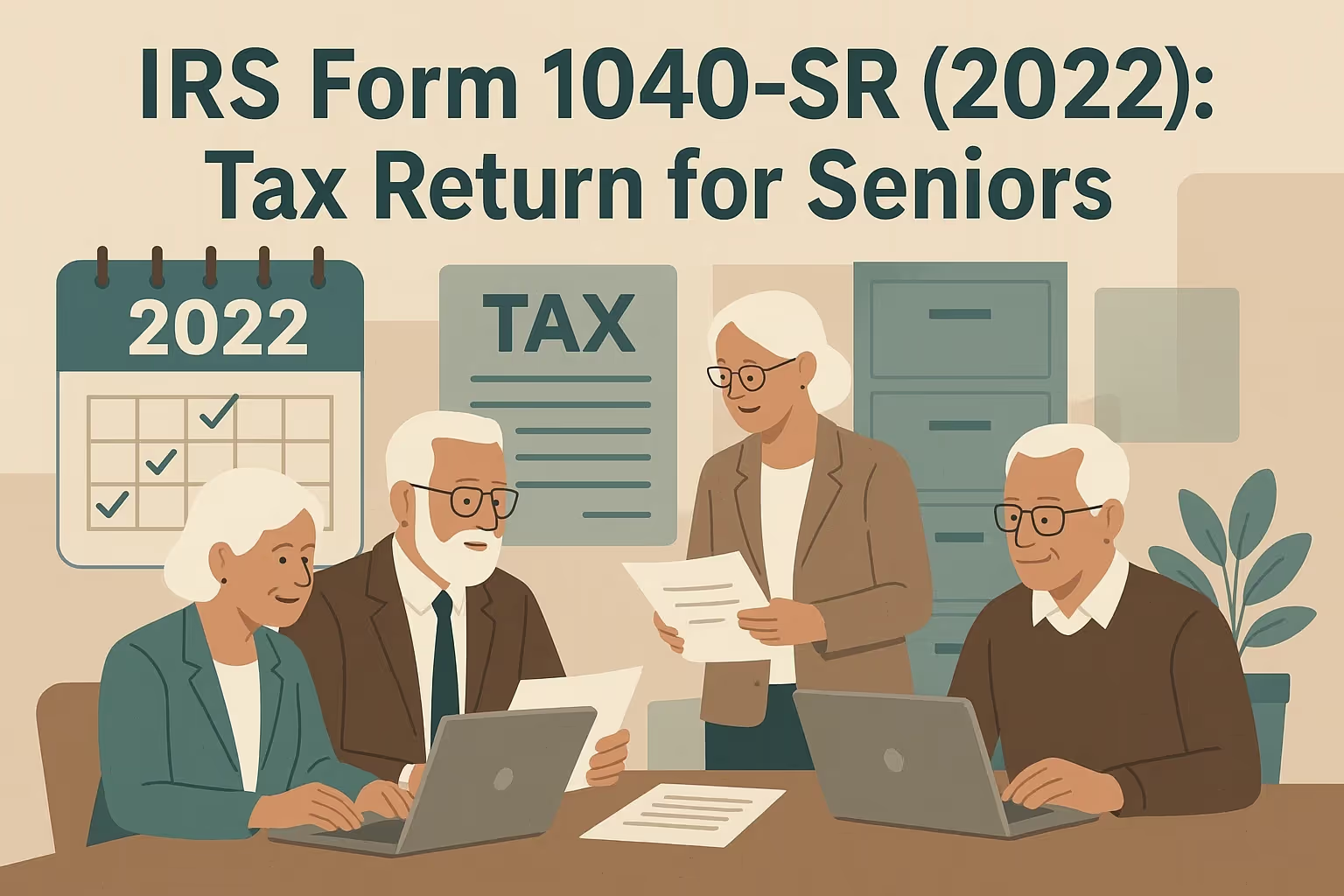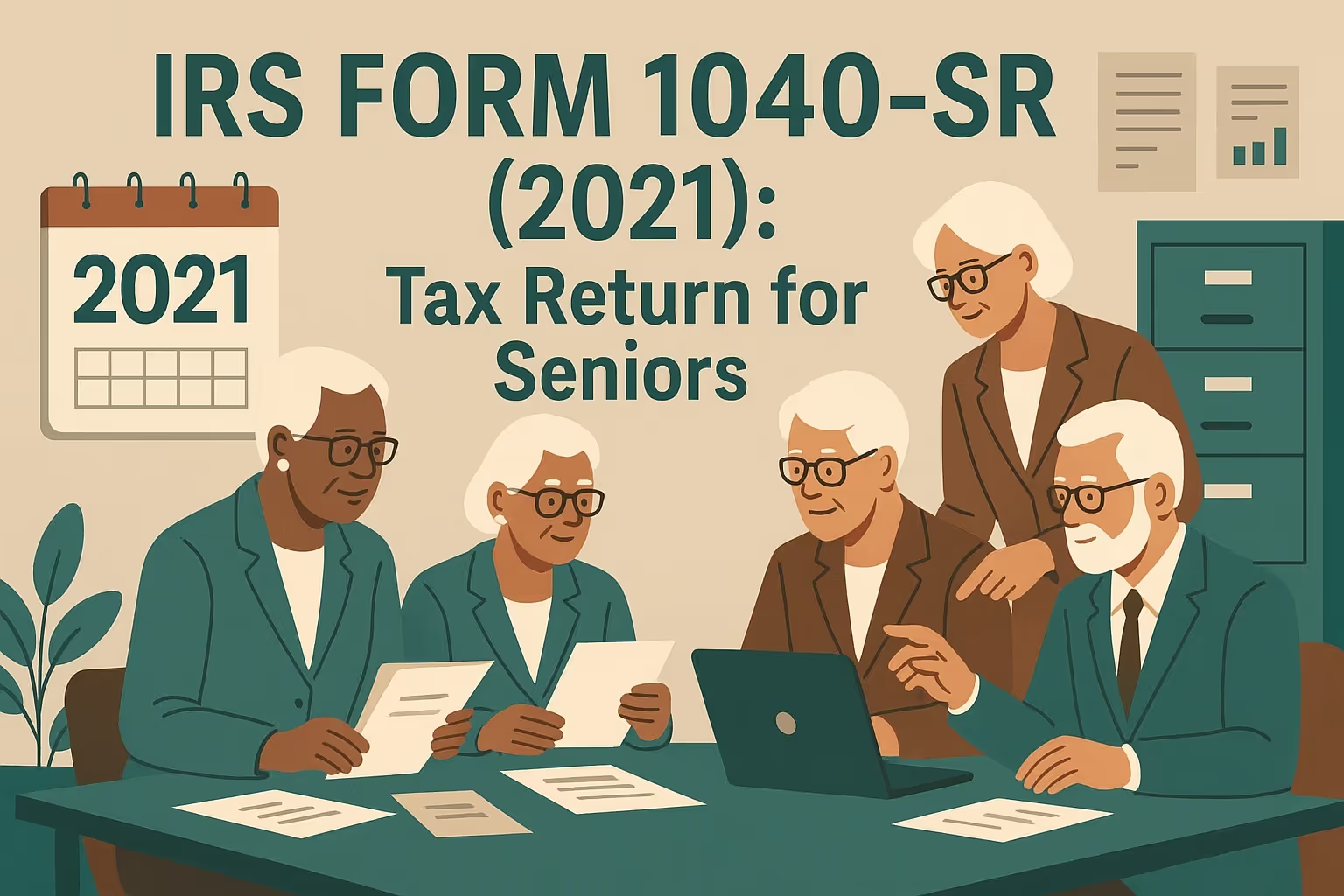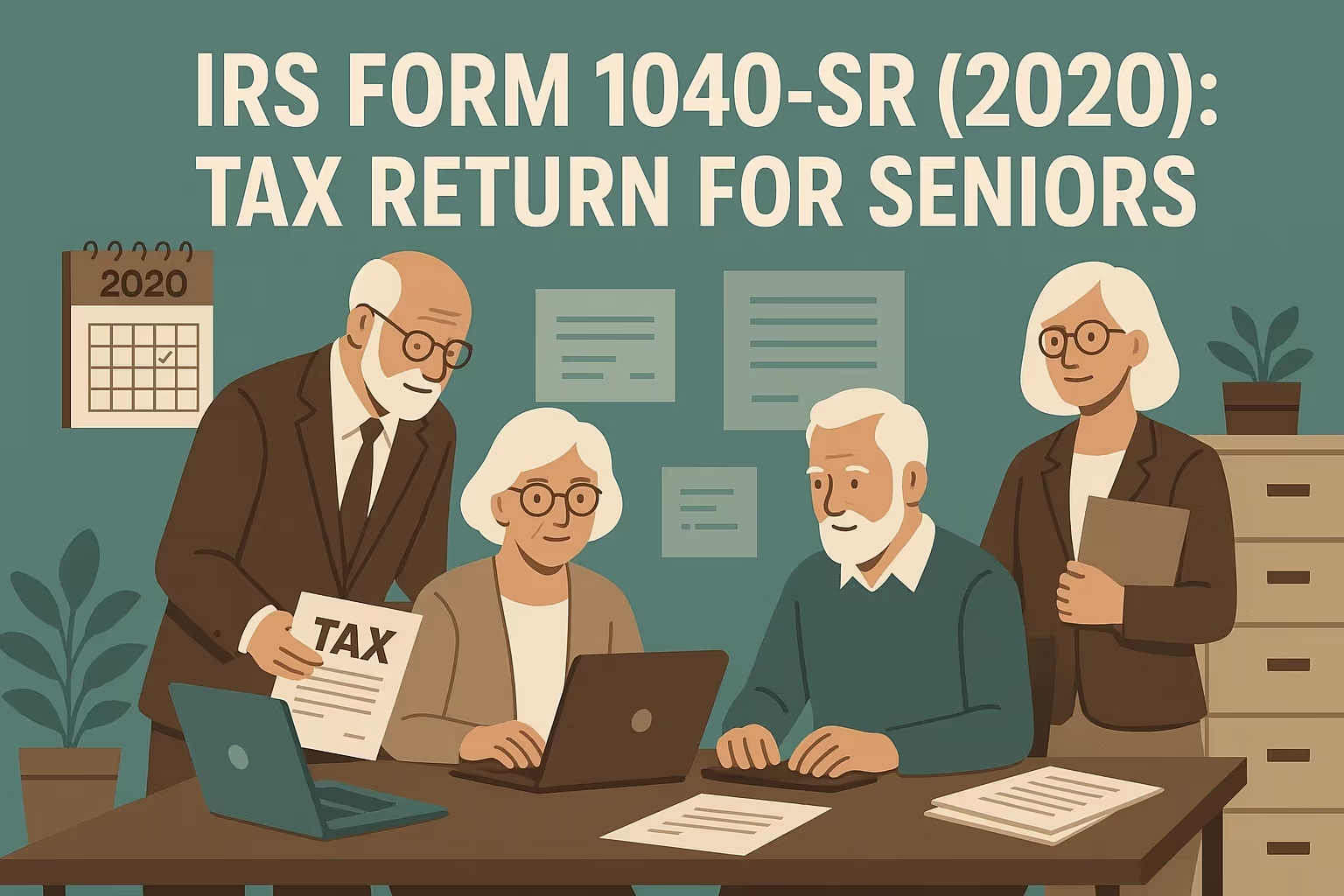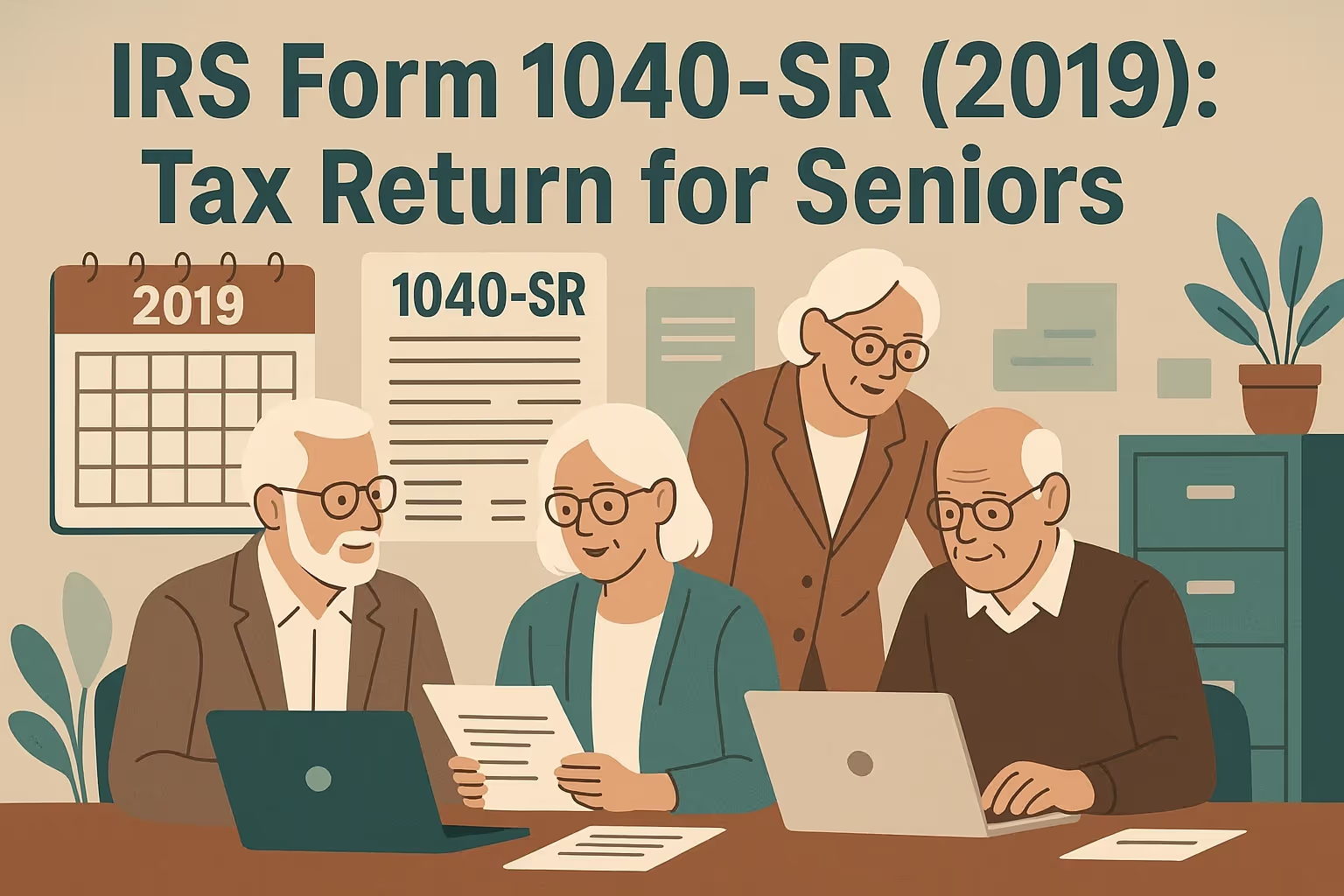Form 1040SR 2015 Instructions: Complete Guide for Seniors
Filing a federal tax return for 2015 required seniors to use the same schedules and forms as other taxpayers. While Form 1040SR did not exist until 2019, older taxpayers still had access to unique benefits and deductions designed to help reduce their tax filing burden. This guide provides detailed instructions and step-by-step guidance tailored for individuals aged 65 and above, making the process clearer and more manageable.
Seniors had several options depending on their income, deductions, and filing status. Some forms were intended for straightforward, simple tax situations, while others were suitable for more complex income scenarios. Choosing the right form was essential to ensure accuracy, avoid owing additional taxes, and secure the maximum refund available under the law.
This article organizes the filing process for seniors who need to file in 2015. Each section clearly outlines the specific requirements, available deductions, relevant schedules, and tax credits applicable that year. It also highlights where free expert assistance or software could help improve accuracy, minimize questions, and provide a reliable way to complete the filing today.
Overview of Available IRS Forms for Seniors in 2015
In 2015, senior taxpayers could use three different forms depending on their income tax situation. Each form supported various levels of complexity, and selecting the right one made the process easier.
Form 1040EZ
- Eligibility requirements: This form applies only to simple returns with taxable income under $100,000. It excluded dependents, itemized deductions, and limited income sources.
- Best for seniors: Ideal for individuals or married couples filing jointly who want to file quickly without multiple schedules or complicated paperwork.
Form 1040A
- Expanded coverage: Allowed all filing status categories, taxable income under $100,000, and the ability to claim dependents. More income types were accepted compared to the 1040EZ.
- When to use: Best suited for seniors needing additional reporting beyond wages, Social Security, or pensions, but not requiring the full Form 1040 schedules.
Form 1040
- Full coverage: Supported every filing status and allowed unlimited income levels, business income, and deductions such as mortgage interest and medical expenses.
- Comprehensive option: Seniors with complex income tax needs, rental property, or itemized deductions had to file using this complete form for accuracy and compliance.
Senior-specific benefits in 2015
- Higher thresholds: In 2015, seniors needed higher income levels before being required to file a federal tax return, which reduced unnecessary tax filing for low-income retirees.
- Additional deductions: Extra standard deduction amounts for taxpayers 65 and older lowered taxable income, allowing seniors to reduce taxes owed and potentially qualify for larger refunds.
- Credits available: The Credit for the Elderly or Disabled offered eligible seniors direct tax relief up to $1,125, significantly reducing federal tax liability when income limits were met.
What Changed for Tax Year 2015
Taxpayers filing a federal tax return for 2015 needed to acknowledge several updates. Seniors received specific adjustments that reduced taxes owed, making filing less burdensome.
Filing deadlines and state extensions
- General deadline: April 18, 2016, applied due to the Emancipation Day holiday in Washington, D.C.
- State adjustments: Taxpayers in Maine and Massachusetts had until April 19, 2016, because of the Patriots’ Day holiday.
Standard deduction amounts and senior add-ons
- The base amounts are $6,300 for single filers, $12,600 for married filing jointly, and $9,250 for the head of household.
- Senior adjustments: An additional $1,550 for single or head of household filers age 65+, and $1,250 per qualifying spouse for married taxpayers.
Medical expense threshold and Affordable Care Act rules
- Medical deductions: Seniors could deduct unreimbursed medical expenses exceeding 7.5 percent of adjusted gross income, while younger taxpayers used 10 percent.
- Health coverage: 2015 was the first full year of the Affordable Care Act’s individual mandate, which required qualifying coverage, an exemption, or a penalty payment.
Filing thresholds for seniors by status
- Single filers: Seniors classified as single had to file a federal tax return if gross income reached $11,850, ensuring income reporting compliance for the 2015 tax year.
- Married filing jointly: Couples with one spouse age 65+ were required to file at $21,850, while both spouses 65+ had a threshold of $23,100.
- Head of household: Seniors filing as head of household must file when income exceeds $14,800, reflecting additional deductions and adjustments available for older taxpayers.
Choosing the Right Form
The choice between Form 1040EZ, 1040A, or 1040 required careful review of income sources, deductions, and schedules. Seniors could use quick decision checks to determine the correct approach.
Quick decision guide for selecting forms
- Itemize deductions: Seniors with mortgage interest, property taxes, or high medical expenses need Form 1040.
- Moderate income: Taxpayers under $100,000 but more than simple wages or Social Security benefits generally use Form 1040A.
- Simple returns: Basic wage earners, pension recipients, or Social Security-only filers could choose Form 1040EZ for a faster and more straightforward process.
Form selection checklist for seniors
- Income limits: Filing status and income under $100,000 supported using Form 1040A or 1040EZ, depending on deductions.
- Itemized deductions: Anyone claiming mortgage interest or higher deductions than the standard amount must file with Form 1040.
- Complex sources: Taxpayers with investments, rental property, or self-employment income had to complete the full Form 1040 with all schedules.
Situations requiring Form 1040
- Business or rental income: Anyone with self-employment, business, or rental activity must use the complete federal tax return Form 1040.
- Capital gains or losses: For accuracy, seniors who sold investments like stocks, bonds, or property in 2015 must file schedules available only with Form 1040.
- Income over limits: Seniors with taxable income above $100,000 were automatically excluded from Forms 1040EZ and 1040A.
Gathering Documents and Records
Accurate tax filing starts with gathering the right information. Seniors filing a federal tax return in 2015 needed specific documents to ensure accuracy and avoid missing income.
Core income forms for seniors
- W-2 forms: Issued by an employer for wages and tips, showing income earned and federal taxes withheld during the year.
- 1099-R forms: Reported pensions, annuities, and retirement distributions. Seniors frequently received these forms, which must be included in the return.
Documents for itemized deductions
- Mortgage interest statement (Form 1098): This statement shows the annual mortgage interest paid, which is important for seniors choosing itemized deductions on Form 1040.
- Medical and dental receipts: Provided proof of expenses above the deduction threshold for seniors, reducing taxable income if itemized.
Recordkeeping and verification tips
- Organized folders: Keeping all tax forms, notes, and receipts in one place helped seniors complete schedules faster and avoid errors.
- Cross-checking details: Comparing received forms against personal records reduced filing mistakes and ensured the accuracy of refund or payment amounts.
Forms, Instructions, and Filing Information
Completing personal details correctly was essential for any 2015 federal tax return. Errors in Social Security numbers or filing status often delay processing or refunds.
Ensuring identity accuracy
- Social Security verification: Seniors had to confirm that names matched records exactly to avoid rejections during the electronic tax filing process.
- Address updates: Moving requires filing Form 8822 to ensure the Internal Revenue Service sends any refund or communication to the correct home address.
Choosing the correct filing status
- Single or married: Filing status determines tax brackets, deductions, and refund eligibility. Seniors must select the correct category carefully.
- Head of household or qualifying widow(er): These statuses offered higher standard deductions but required specific living and dependent situations.
Claiming age and blindness boxes
- Age 65+ checkboxes: Provided seniors with additional standard deduction benefits automatically when marked correctly on their federal tax return.
- Blindness adjustment: Eligible taxpayers could further increase deductions, but accuracy in signing and acknowledging these boxes was required.
Reporting Income Accurately
Seniors needed to report all income sources on their federal tax return. Omitting forms or forgetting to include retirement distributions could cause delays or penalties.
Fully taxable retirement and wage income
- Retirement accounts: Distributions from IRAs, 401(k)s, or pensions were fully taxable and had to be listed under income tax on the return.
- Part-time work: Wages earned from an employer remained subject to withholding and reporting, even if small, and required inclusion in federal taxes.
Interest, dividends, and investments
- 1099-INT forms: Showed interest received from banks or credit unions. Seniors had to include this income on their tax return.
- 1099-DIV forms: Reported dividends paid by mutual funds or stocks, requiring seniors to complete the same schedules as younger taxpayers.
Social Security taxation rules
- Partial taxation: Social Security benefits could be taxable depending on combined income levels, with worksheets included in the 2015 instructions.
- Thresholds: Seniors with combined income over $25,000 (single) or $32,000 (married filing jointly) must report part of their benefits as income.
Annuities, pensions, and retirement boards
- Railroad Retirement Board benefits: Seniors receiving these benefits faced special tax rules, requiring careful reading of IRS instructions for 2015.
- Annuity income: Partially taxable based on cost recovery, meaning seniors must understand how to calculate taxable amounts correctly.
Income Tax Deductions and Credits for Seniors
In 2015, seniors had several opportunities to reduce income tax owed. Deductions and credits made the tax filing process more favorable and often led to a higher refund.
Standard deduction amounts for seniors
- Age adjustments: In 2015, seniors received $1,250 or $1,550 in additional deductions depending on filing status, directly lowering taxable income.
- Blindness addition: Further deductions applied to blind taxpayers, reducing tax owed and helping more seniors qualify for credits or refunds.
When itemizing beats the standard deduction
- Mortgage interest: Seniors paying significant mortgage interest often benefit from itemizing, especially if combined with property taxes and charitable donations.
- Medical expenses: With a reduced 7.5 percent threshold, seniors itemizing medical costs could more easily exceed the standard deduction than younger taxpayers.
Medical expense deduction advantages
- Lower threshold: Seniors could deduct medical costs above 7.5 percent of adjusted gross income, providing substantial relief in cases of high healthcare spending.
- Proof required: Detailed records were essential, and receipts had to be retained even if not sent with the return to maintain compliance.
Credit for the Elderly or Disabled
- Eligibility: Available to seniors age 65+ or individuals retired on permanent disability, subject to income limits for both federal and state taxes.
- Value: Provided a nonrefundable credit up to $1,125 in 2015, directly reducing federal tax liability and often increasing the possibility of a max refund.
How to File Your Federal Tax Return
Seniors filing their 2015 federal tax return had multiple methods available. Choosing the right file method affected speed, accuracy, and whether refunds were received.
E-file options and Free File programs
- Electronic filing: The fastest way to file, with refunds typically issued within two weeks, and accuracy enhanced by built-in software checks.
- Free File: Available to taxpayers with adjusted gross income of $62,000 or less in 2015, offering guided instructions and simple online completion.
Paper filing requirements
- Manual filing: Some seniors preferred paper. Using black or blue ink, attaching required forms, and signing correctly were critical to avoid rejection.
- Processing time: Paper returns took longer to process, often six to eight weeks, delaying the refund and increasing the risk of missing information.
Free assistance programs for seniors
- VITA program: Offered free filing help to individuals with income under $54,000, including seniors needing expert assistance with schedules and deductions.
- AARP Tax-Aide: Provided seniors with expert help through community locations, ensuring accuracy and support for the 2015 tax return questions.
Payment Instructions if You Owe
Some seniors filing a federal tax return for 2015 owed taxes after completing forms and schedules. Understanding payment options helped avoid penalties and ensured timely processing.
When payments are due
- Original deadline: For the 2015 tax year, all taxes owed were due by April 18, 2016, even if seniors requested an extension to file paperwork.
- Late payment impact: Missing this deadline meant paying interest and penalties, which continued until the IRS received the full amount.
Electronic payment methods
- IRS Direct Pay: Allowed taxpayers to pay directly from a bank account using a secure device, immediately acknowledging received payments.
- Debit or credit card: This option offers flexibility to pay taxes, though convenience fees are applied, making it slightly more expensive than direct transfers.
Payment plan options
- Short-term plan: Seniors could request up to 120 days to pay their balance without setup fees, but interest and penalties continued accumulating until taxes were fully paid.
- Long-term installment agreement: Seniors unable to pay immediately could submit Form 9465 to establish monthly payments, creating a manageable way to reduce larger tax liabilities over time.
Required Schedules and Attachments
Some tax filing situations required extra schedules and attachments. Seniors filing with Form 1040 could access deductions and credits unavailable on simplified forms.
Key schedules used by seniors
- Schedule A: Allowed itemized deductions such as mortgage interest, property taxes, and medical expenses above the adjusted gross income threshold.
- Schedule B: Required when interest or dividend income exceeded $1,500, ensuring all income was properly reported for accuracy.
Schedule R: Credit for the Elderly or Disabled
- Purpose: Enabled seniors age 65+ or individuals on permanent disability to calculate and claim the credit directly.
- Alternative option: Seniors could check a box on Form 1040 and allow the IRS to compute the credit, though this sometimes delays the refund.
Attachment requirements
- Attach documents: Seniors filing paper returns had to attach W-2 forms, 1099-R forms, and any tax-withheld documents before mailing.
- Keep for records: Receipts for medical expenses, charitable donations, and other deductions should be retained, even if not sent with the return.
Common Mistakes to Avoid
Mistakes in tax filing delayed refunds or increased taxes owed. In 2015, seniors often made common errors that could have been prevented with expert help or software.
Social Security numbers and names
- Frequent errors: Numbers entered incorrectly or names not matching Social Security records caused rejections or delayed processing.
- Prevention: Seniors had to double-check accuracy before signing and sending their tax return to ensure smooth processing.
Filing status and deductions
- Incorrect status: Choosing the wrong filing status reduced refunds or increased taxes owed unnecessarily.
- Missed deductions: Forgetting senior-specific deductions or mortgage interest payments lowered the chance of receiving the max refund.
Missing or misreported income
- Unreported income: Failing to report income from 1099 forms or retirement distributions often caused IRS notices, delayed refunds, or added penalties.
- Solution: Keeping all forms together and reviewing them against instructions ensured complete reporting.
Zero-Activity or Dormant Year Guidance
Some seniors did not need to file a federal tax return in 2015. However, filing could still be beneficial even when income levels fell below thresholds.
When a filing is not required
- Income thresholds: Seniors below filing thresholds with no taxable income sources were not required to file, saving time and money.
- Social Security only: Benefits remained non-taxable if combined income fell under $25,000 for single filers or $32,000 for married filing jointly.
Benefits of filing anyway
- Refund opportunities: Filing ensured refunds of taxes withheld were received, even if no taxes were otherwise owed.
- Tax record: Filing creates an official record useful for future questions or applications requiring proof of tax compliance.
Required filing regardless of income
- Self-employment income: Seniors who earned $400 or more from self-employment during 2015 were required to file a federal tax return, regardless of other income sources.
- Other obligations: Advance premium credits, household employment taxes, or health savings account distributions triggered mandatory filing.
First-Time Filer Tips for Seniors
Some seniors filed a federal tax return for the first time in 2015. Clear steps and expert guidance made the process simple and helped reduce stress.
Step 1: Determine if you need to file
Seniors used filing requirement charts or the IRS Interactive Tax Assistant online to decide whether to file based on income and age.
Step 2: Choose your filing method
E-filing provided the fastest refunds, while paper filing required more time. Seniors without devices could contact tax experts or free programs for help.
Step 3: Gather documents before starting
All W-2, 1099, and SSA-1099 forms must be collected before filing. Keeping complete information prevented mistakes and delayed refunds.
Step 4: Complete the correct form
Seniors with simple returns could use Form 1040EZ. More complex returns with deductions or multiple income sources require Form 1040A or Form 1040.
Step 5: Review and sign before sending
Every federal tax return requires a signature before mailing or electronic submission. Seniors had to read carefully and acknowledge accuracy before submitting.
Frequently Asked Questions
Do I need to file a tax return if I only receive Social Security benefits?
Seniors whose only source of income is Social Security often do not need to file a tax return unless their total income surpasses the taxable thresholds. However, some seniors still opt to file to claim refunds for withheld taxes, keep a filing record, or qualify for credits that can provide extra funds.
What is the difference between Forms 1040, 1040A, and 1040EZ for seniors?
Form 1040A was used for income tax situations with moderate complexity and an income of less than $100,000, while the 1040EZ was designed for simple income tax situations. Seniors with deductions, mortgage interest, or complex income sources required the complete Form 1040. The right option was essential for accuracy, compliance, and eligibility for the highest possible refund amount available in 2015.
How much additional standard deduction do I receive at age 65 or older?
For 2015, seniors filing as single or head of household received an additional $1,550, while married filers gained $1,250 per qualifying spouse. Blind seniors also received the same additional deductions. These amounts reduced taxable income, helping many older taxpayers qualify for valuable credits or achieve a higher refund when they filed their return.
Can I deduct medical expenses as a senior, and what threshold applies in 2015?
In 2015, seniors could deduct unreimbursed medical and dental expenses exceeding 7.5 percent of adjusted gross income. This lower threshold compared to younger taxpayers allowed many older filers to reduce their taxable income significantly. Proper recordkeeping and receipt retention were necessary to ensure eligibility and compliance when claiming these deductions on the tax return.
What is the Credit for the Elderly or Disabled, and who qualifies in 2015?
This credit was available to seniors 65 or older or those under 65 who retired on permanent disability. Qualification required meeting specific income limits. The credit could reduce taxes owed by up to $1,125. Seniors could either calculate the credit using Schedule R or check a box and have the IRS compute it.
How do I report pension and 401(k) distributions on my 2015 return?
Distributions from pensions, annuities, or retirement accounts like 401(k)s were reported using Form 1099-R. Seniors had to include the full taxable portion on their federal tax return. Any non-taxable amounts, such as cost basis recovery for annuities, require a separate calculation using IRS worksheets to ensure accuracy. Failure to report correctly could result in penalties or delayed refunds.
Should I use an e-file or paper-file for 2015, and which option is better for seniors?
E-filing was generally better for seniors in 2015 because it was faster, more accurate, and confirmed immediately when the IRS received the return. Paper filing, while still accepted, often took weeks longer to process. Seniors without access to devices or software could find expert help through programs like VITA, TCE, or AARP Tax-Aide for reliable support.


















